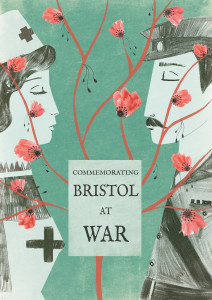Two Brothers from St Philips and their First World War

Share this
In the Western Daily Press of 16th November 1916, there was a photograph of ‘Alfred Leonard Jefferies, late of 33 Edward Street St Philips Bristol’ who had been ‘killed in action’ in France. ’Much sympathy is expressed’ said the report.
But Alfred was not ‘killed in action’. He had been shot at dawn on 1 November 1916 for attempting to desert from the 6th Battalion of the Somerset Light Infantry by trying to catch a ferry back to England. We cannot now know why the Army reported the his death in this way; perhaps they did not wish his family or readers in Bristol to know the full truth. Perhaps it was because Alfred’s brother Arthur had been killed in action in the same battalion two months earlier.
Alfred Jefferies was from a large working class family from St Philips. Born in 1886 to Leonard and Georgina Jefferies, he had several brothers and sisters. Leonard died in 1894.By 1911 Alfred was working at Lysaght’s metal galvanising factory. His brother William also worked there. Arthur worked at a bottle factory; he was married with two young sons. Sister Beatrice was working in a tobacco factory and Mary was a box maker. The Jefferies Brothers were among hundreds of working men from East Bristol who fought and died in the War. Dozens of Lysaght’s workers enlisted in the first few months of the war.
Alfred sailed to France in May 1915. Arthur later joined him but he was killed at the Somme on 16 September 1916. 41 men died that day, and 143 were listed as ‘missing’. His death was reported in the Western Daily Press on 17th October 1916.
But Alfred had deserted in August and was awaiting court martial when Arthur was killed.
Alfred’s War
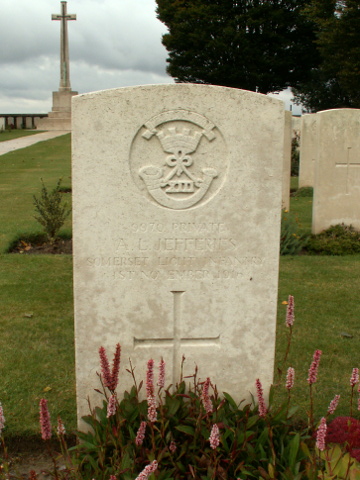
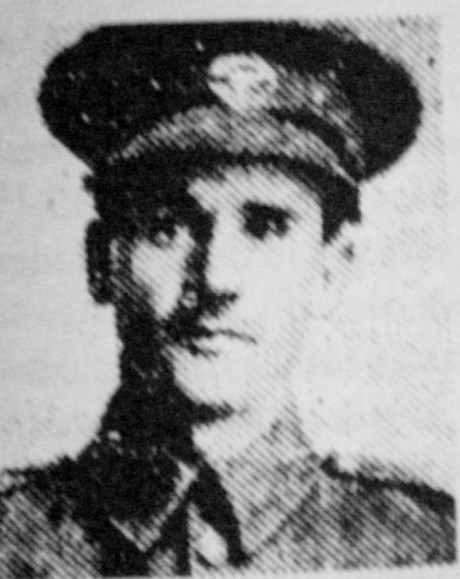
Within the first month of his war, in June 1915, Alfred was wounded in his right eye at the Ypres Front. He returned to the fighting in August 1915, but was later gassed and hospitalised in Boulogne with shell shock. In July 1916 he was back in the thick of action at the Battle of the Somme with thousands of casualties. On 16 August, there was a gas attack near Delville Wood and Montauban. Late that night Alfred went missing from the trenches. He boarded a train bound for Le Havre, but was arrested there by military police, and taken back to the Battalion’s rest camp near Albert. He was court martialled on 9 October 1916.
Like most ‘field’ courts martial, the process of justice was rudimentary. Most of the evidence was given by NCOs and senior officers, but there was no defence lawyer or doctor to give evidence about his health. An orderly room clerk at Le Havre had challenged Alfred Jefferies to produce a leave pass, but he did not have one. Apparently he was wearing a shoulder badge of the Durham Light Infantry on his cap, and said his name was ‘Jones’. The clerk told the court martial ‘ ..he was, in my opinion, mentally off his balance…’ A sergeant and two privates said they had seen him during the day of 16 August in the reserve trench but not later that night. Two officers gave perfunctory character references, though one said he had been a ‘good … reliable soldier’.
In his defence, Alfred Jefferies explained that he had been wounded, suffered shell shock and hospitalised. The file does not show whether he had any good reason to leave the trench, but like many others, he would have been disoriented in the thick of a battle.
His fate was sealed by a Lieutenant Colonel who wrote on the file:
No 9970 Pte A Jefferies has never shown much courage and has never been of any value as a fighting man. On the night of his desertion he could not have had any certain knowledge that the battalion was to attack 2 days later but I believe that he deliberately absented himself with the object of avoiding what he must have known lay before him in the near future.
The papers suggest that the high command were keen to make an example of Alfred Jefferies. In the battle the day after he had boarded the train, several officers and 48 other ranks were killed. The file was referred up the chain of command. Both Brigadier Wood and Major General Couper recommended that ‘the extreme penalty be inflicted’. Commander in Chief General Haig signed his approval on the file .
So the death sentence was approved, notwithstanding Alfred Jefferies’ record.
He was shot at 6 10 a.m. near the village of Penin on the 1 November, by a firing squad of men from the Duke of Cornwall’s Light Infantry. The execution was overseen by the military police led by A L Brown, Assistant Provost Marshall of the 14th Army Division.
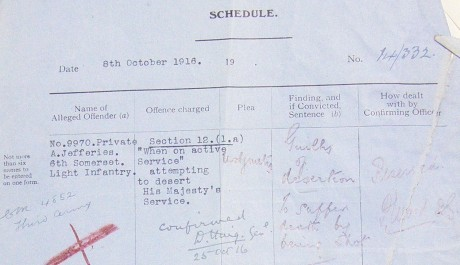
The Pardon
On the Western Front, nearly 3000 soldiers were sentenced to death for desertion, cowardice and other military offences under the Army Act, but only about 300, like Alfred Jefferies, were executed. The remainder served time in prison or other punishments. Campaigners on behalf of those shot for desertion argued that they had been subject to rough justice. In 2006 the Secretary of State for Defence Des Browne issued a posthumous pardon to all those affected.
Alfred Jefferies is commemorated by a headstone at the Arras Road memorial at Roclincourt, north of the Somme valley. Both he and Arthur are listed in the Somerset Light Infantry Roll of Honour. The memorial plaque at St Silas British Legion club in Philips includes the name ‘A Jefferies’; this could refer to Arthur of Alfred or both brothers…..
General Douglas Haig, the Commander in Chief of the Army in 1916, is commemorated by statues in Whitehall in London and at his Bristol school, Clifton College.
Georgina Jefferies lived as a widow at 33 Edward Street St Philips until she died aged 85 in 1937. The St Philips and Dings area houses where her family lived have long since been demolished.
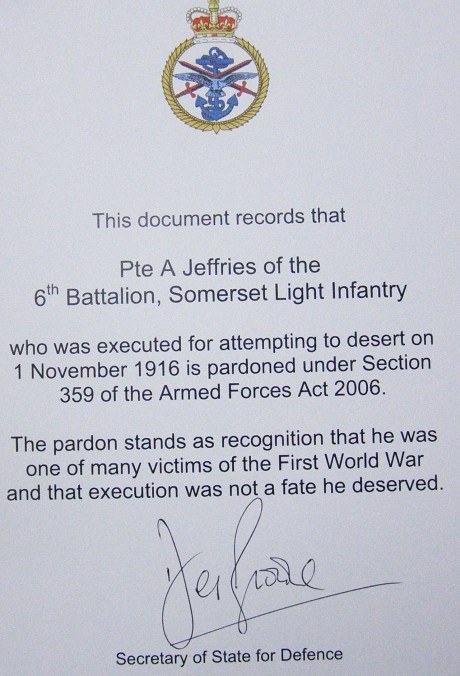
Notes
Arthur and Alfred Jefferies are referred to in ‘Shot at Dawn’ by Julian Putkowski and Julian Sykes (1989) Pen and Sword Books.
‘For the Sake of Example’ by Anthony Babington (1983) Leo Cooper/Secker and Warburg sets out the background to death sentences during World War One. Brief details of cases are given, including Alfred Jefferies, but without the names of each individual soldier.
The names and many details of all those sentenced to death are included in Gerald Oram’s book‘’Death Sentences passed by the military courts of the British Army 1914-1924’ (1998/2005) Francis Boutle publishers
Chris Howell’s ‘No Thankful Village’ (2002) Fickle Hill, contains the memoir of Lance Corporal
George Taylor, who was in the 6th Battalion of the Somerset Light Infantry. On page 131 he recalls what happened to the Jefferies brothers. It is a moving account but his story differs in some respects from that revealed by the court martial papers. Taunton Heritage Centre has a copy of the War Diaries of the 6th Battalion of the Somerset Light Infantry.
Thanks to Barton Hill History Group for their help.
Images from top: Private Jefferies, newspaper photo, 1916.
A L Jefferies headstone, Arras Road Cemetery.
Court martial file page schedule.
Certificate in FCGM file with posthumous pardon.
